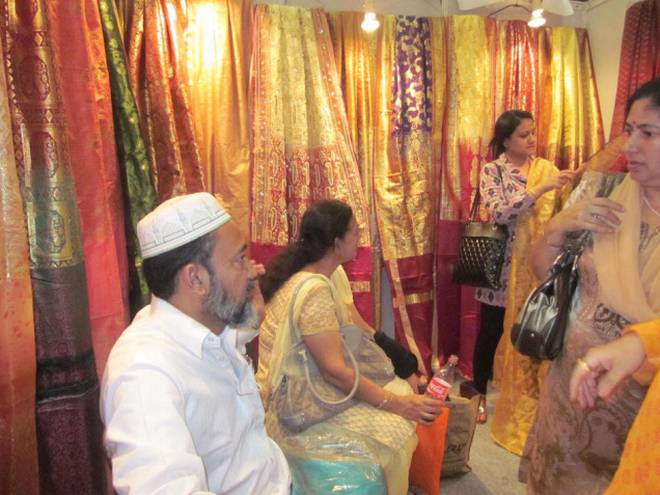Article published in The Hindu Sunday Magazine. 24 December 2011
Dam ka Qeema mix, Haleem mix, Barbeque Biriyani mix, Paya mix, Karahi Gosht mix, Seekh kebab mix. As I scanned the glossy expanse of spice mixture packets used for pepping up a myriad of delicacies, I was instantly tempted to buy a packet of each from the Habib Spice Stall where they were on display at the Pakistan pavilion of the recently concluded India International Trade Fair.
Accompanied by drool-worthy pictures of the dish, complete with directions to cook it the traditional Pakistani way, these spice offerings were truly hot. A Karachi-based company, Habib was one of the few spice brands which set up shop at the trade fair. “Habib has been exhibiting at the IITF since two years,” says stall manager Mustafa Hasan. “Shan (another spice brand) has been exhibiting its products at the IITF since six years,” he adds. Shan and Habib, I am told, are major rivals in the spices segment of Pakistan. “There are 70 Pakistani exhibitors. If more space had been allotted, more exhibitors from Pakistan would have come forward,” Mustafa says.
Most of the spices on sale are meant to flavour non-vegetarian dishes. “Indians are mostly vegetarian, while in Pakistan, the diet is predominantly non-vegetarian,” says Mustafa, echoing a widely-held belief regarding the food habits of the two countries. However, sales are brisk.
Persisting beliefs
As we speak, Mustafa tells me that he is interested in buying Indian ethnic goods. He has visited Fabindia and wants more suggestions. Based on my limited knowledge, I ask him to visit the Cottage Industries Emporium, Dilli Haat and Khadi Emporium. Mustafa has heard of the first two.
Moving on, I see Sabeen Akbar, Chief Executive of her clothing enterprise, using her persuasive skills to convince a woman to buy a richly embellished suit piece. She quotes a high price. “These goods would not be so expensive if they were not hand-made. Karachi deals mainly in manufactured goods while handmade items can be found in Multan,” she says.
As I roam from stall to stall, I ask how business has been and get mostly discouraging replies. “The buying power of Indians has decreased,” claims Jehangir Iqbal Khokal whose stoles and suit pieces did not find too many takers.
Folding a dressy cotton suit, Mohammed Salim from a neighbouring stall says that sales have not been too good. “People baulk at the prospect of paying more than Rs. 1,000 for cotton. They are oblivious to the amount of labour needed for work on the material itself.”
For many of the exhibitors, the sales raked in at the fair are not as crucial as the materialisation of partnerships with Indian traders and sellers. A.N. Alim Ahmad, whose exquisite silk saris from Bangladesh are drawing interested buyers, says, “The partnerships that we had hoped for are not developing. We want Indians to sell our goods here. But the people on the Indian side want our goods on credit which we cannot agree to,” he says.
I spend some time at the stall admiring the brilliant greens and fiery reds and golds that come to life on China silk and Bangla silk material. The saris don't come cheap and start from Rs. 2,200. At another emporium, Afsaruddin, a salesman, is delighted to hear me speak Bengali. He exclaims: “Thank God someone speaks Bengali!” Jamdani silk and muslin have sold rapidly, I am told.
Here too, the saris are exorbitantly priced. Afsaruddin claims that Bangladeshi women purchase saris worth Rs. 50,000 without batting an eyelid. “Here you tell the women that a sari costs Rs. 3,000, they baulk even if they have the money,” he says. Jute and silk saris are the main items of sale at the Bangladesh pavilion.
I head to Hall number 18 which was hosting the exhibits of a number of other countries. The Turkey pavilion immediately beckoned me with its brilliantly coloured and bewitching lanterns and lamps in all possible hues and shades. The eyes and flashbulb were both extremely gratified. It was a pleasure to just stand there and muse on the warm lighting and note every glint and wink of the coloured lights. I trooped to the nearby Afghanistan pavilion where stall managers were kept busy with purchasers buying dry fruits in bulk. Mainly from Mazar-e-Sharif, the most lapped up items were anjeers, chilkot, dried mulberries, giant raisins and khurmanis. Saffron from Herat saw interested buyers but not much sale owing to the high rates. Qudratullah Rahmati of the Afghan Saffron Company said his sales had not been satisfactory owing to the proliferation of saffron stalls.
The security cops, however, hung around the saffron stall demanding that saffron should be mixed with the water they were drinking!
Learning experience
More wandering took me to the carpet stall of Muhammad Hanif Rahim. This is Muhammad's maiden participation in the IITF. For Muhammad, this experience has been about learning about Indian culture as much as it is about getting to know customer requirements. “Indians demand smaller carpets while Afghans buy much bigger ones,” he says. “Each room in an Afghan house must have a carpet.”
The carpets which are made at Mazar-e-Sharif are priced at US$ 200 per square metre and created by local artisans in their homes. They are made of wool sourced from Australia and China.
Does the instability in Afghanistan prevent them from doing work? “We find it difficult to sell Afghan goods to foreigners in Afghanistan,” answers Muhammad. This is because “foreigners don't come to Afghan bazaars and stay in their bases. But the local demand is very good.” Mazar-e-Sharif, claims Muhammad is one of the safest places in Afghanistan. More stalls beckoned, but my tired feet stopped only once — to sample an Iranian date which was being offered to taste. I have never bitten into a softer or more tasteful date.
Cover photo: Urvashi Sarkar
Read the original article: https://www.thehindu.com/features/magazine/the-neighbourhood-bazaar/article2744455.ece

